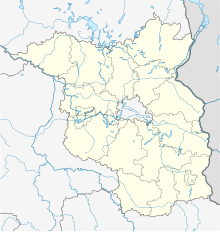Grumsiner Forest / Redernswalde
Coordinates: 53 ° 0 ′ 0 ″ N , 13 ° 50 ′ 0 ″ E
The nature reserve Grumsiner Forst / Redernswalde is a 6157.89 hectare nature reserve in Brandenburg .
location
The nature reserve is located northeast of Berlin and extends over the area of the cities of Angermünde ( district of Uckermark ) and Joachimsthal as well as the communities of Althüttendorf , Friedrichswalde and Ziethen (the latter district of Barnim ). The highest point is the approximately 139 m high Blocksberg.
The A 11 runs through the nature reserve .
history
The landscape was essentially formed in the last Vistula Ice Age . Terminal moraines and moraine plates remained, which led to a strong relief formation in the landscape. Alder quarries, moors and lakes formed there. At the time of the GDR , the state hunting area was designated, i.e. it was forbidden to enter and without intensive forestry use. At the same time as the Schorfheide-Chorin biosphere reserve was established, the nature reserve was placed under protection as nature reserve No. 23 on October 1, 1990. Due to the lack of agricultural use, the forest could become a retreat for rare animal species such as the spotted eagle or the black stork . Due to the positive development of the area, on June 25, 2011, 590 hectares of the Grumsin became part of the UNESCO World Heritage Site " Primeval Beech Forests and Old Beech Forests of the Carpathian Mountains and other regions of Europe ", which in Germany also includes the Hainich , Kellerwald-Edersee and Jasmund national parks as well as the Serrahner part of the Müritz National Park belong.
Flora and fauna
An area of 847.91 hectares of the nature reserve is designated as a total reserve. In this precipitation water fed lakes are kettle holes and siltation Moore separated from glacial Endmoränenzügen. There are also beech forests here, which are considered to be remnants of the extensive beech stands that used to exist in Central Europe. 349 higher plant species have been recorded in the forest area, four of which are on the red list, such as the white forest bird . In the area grow plants such as Carex limosa , the marsh tea , the Bogbean that Drachenwurz and the water spring .
The dead wood is wood insects such as the head Horn Schröter or bar Schröter inhabited. The air is populated by the white-tailed eagle , the crane , the black woodpecker , the small woodpecker , the green woodpecker and the black stork.
Beech forest Grumsin

The Grumsin beech forest lies in the southwest of the nature reserve. This is a base-rich lowland beech forest that covers an area of around 590 hectares. Archaeological excavations in the area have revealed traces of settlement from the Neolithic and Bronze Age, as well as Slavic settlement sites from the 12th and 13th centuries. In contrast to this, hardly any evidence of settlement has been found in the period from 1500 to 1750. It is certain that the area was used for hunting at the end of the 16th century . For this purpose, part of the area was fenced in over a length of over 70 km and cared for by fence setters and fence keepers. They settled on the outskirts of the area and founded towns there such as the nearby Grumsin. At that time the beech was already dominating the forest area. At the beginning of the 19th century there was more intensive agricultural use. Land was drained in order to cultivate arable land. From the 1950s onwards, there was heavy felling for the extraction of construction timber and firewood. In 2012, experts found five previously unknown species of mosquito in the forest.
See also
literature
- Frauke Gränitz, Luise Grundmann on behalf of the Leibniz Institute for Regional Geography Leipzig and Saxon Academy of Sciences in Leipzig (ed.): Around Eberswalde, Chorin and the Werbellinsee. A geographical inventory in the area of Eberswalde, Hohenfinow and Joachimsthal (= landscapes in Germany. Values of the German homeland . Volume 64). Böhlau Verlag, Cologne / Weimar / Vienna 2002, ISBN 3-412-02401-5 .
- State Office for Mining, Geology and Raw Materials Brandenburg (Ed.): Geological overview map 1: 100,000. District of Uckermark (= geological overview map 1: 100,000. Map of the formations on the surface with representation of selected geotopes and geological objects . Map 4). Land surveying and basic geographic information Brandenburg , Potsdam 2005, ISBN 978-3-7490-4606-5 .
- Ministry for the Environment, Health and Consumer Protection of the State of Brandenburg (Ed.): Buchenwald Grumsin , July 2014, p. 12.
Web links
- World Heritage beech forests
- World Natural Heritage Grumsin , accessed on December 1, 2018.
Individual evidence
- ↑ According to the protected area information in the state of Brandenburg , according to other information 6,154.43 ha
- ↑ Ordinance on the establishment of nature reserves and a landscape protection area of central importance with the overall designation Biosphere Reserve Schorfheide-Chorin of the Council of Ministers of the German Democratic Republic of September 12, 1990
- ↑ Press release of the German Commission for UNESCO, June 25, 2011




